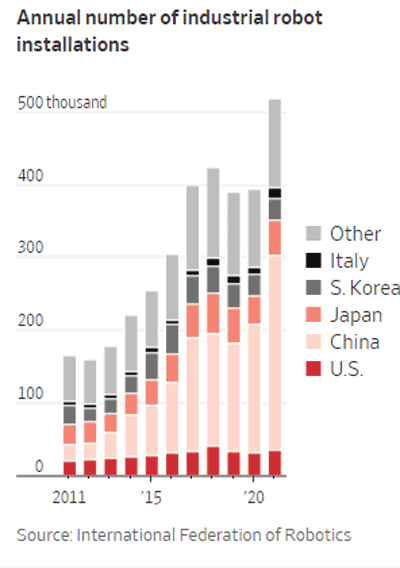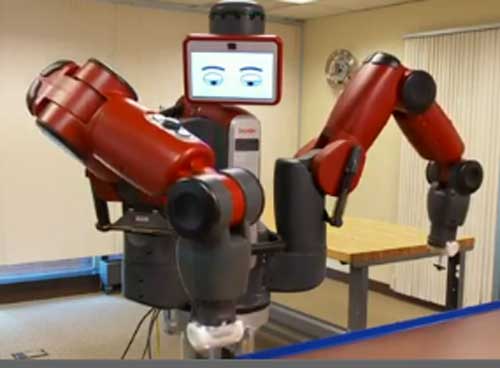First, my hats off and respect for current and former veterans on this Veterans Day.
Much has been written and discussed on the rise of robots, but mass deployment of robotics in manufacturing and logistics always seems to be right around the corner.
Some of you may even remember GM's disastrous foray into industrial robots in the 1980s under then CEO Roger Smith, that badly failed and led to robots being ripped out of the GM factory floor.
But the dynamics are different today. The robots keep getting smarter and more flexible – and in many cases cheaper.
Gilmore Says.... |
 |
| There are some real collaborative robot examples, to my mind most notable mobile robots for use in order picking in a distribution center. |
 |
What do you say? |
|
| Click here to send us your comments |
| |
|
|
|
Add to that there are shortages of labor across the globe – and rising wages naturally along with that.
All that makes the ROI of robotics stronger and stronger, and often changes the ROI from driven just from cost reduction to also more reliably making and shipping goods for customers.
Some recent numbers confirm the thesis that the robot era has begun: In mid-October the trade group the International Federation of Robotics reported that about 500,000 industrial robots were installed globally in 2021, not surprisingly an all-time high and 22% more than the previous annual record set in 2018. (See graphic below.)
So I am talking about a new robot era. The more fanciful term being thrown around these days is “roboconomy.” It’s not exactly a bold prediction, but the Wall Street Journal recently noted that “Even more than we do now, in the future we will depend on robots to grow our food, make our goods, care for our elderly and continue to grow the global economy.”
Remember that in 2018, Elon Musk tweeted that “humans are underrated” and that excessive automation at Tesla was a mistake.
He seems to be changing that tune. In September, Musk showed off an early prototype of a humanoid robot called Optimus.
Musk said it will soon sell for less than $20,000 and that it will eventually be used somehow in production of Tesla vehicles.
“It will, I think, turn the whole notion of what’s an economy on its head, at the point at which you have no shortage of labor,” he said.

Source: Wall Street Journal
Ah, and there is the rub. If there will be no shortage of labor due to deployment of robots on the factory floor, eventually that has to mean much fewer jobs for humans, right?
It’s not going to happen overnight, and in an optimistic view maybe the robots mostly just suck up the labor shortage and have a modest impact on jobs for human beings.
I think that is how it will largely play out with self-driving trucks. It will take years for even this to happen, but I believe eventually autonomous trucks will play a significant role in point to point, long haul freight moves. But no one is really going to mourn the loss of these tough jobs, with multiple days away from home, sleeping the back of a truck for a week, eating bad for you foods, etc.
But believe it will be many more years before self-driving trucks are ready to navigate streets off the highway, or make multiple pick-ups and deliveries everyday as less-than-truckload (LTL) drivers do. The total driver jobs may not take a huge hits from automation.
 There have also been at least a few books written about humans and robots working happily side by side, or somehow in tandem processes. This is sometimes positioned under the category of “collaborative robots,” whose face for a few years at least was “Baxter” from Rethink Robotics, which (who?) sadly left the market after a few years for the lack of a killer app. There have also been at least a few books written about humans and robots working happily side by side, or somehow in tandem processes. This is sometimes positioned under the category of “collaborative robots,” whose face for a few years at least was “Baxter” from Rethink Robotics, which (who?) sadly left the market after a few years for the lack of a killer app.
But there are some real collaborative robot examples, to my mind most notably mobile robots for use in order picking in a distribution center.
In this model, a worker stays in a relatively small area or zone, to which arrive a regular stream of robots with totes on them. The worker places picked items into the robot tote(s), and the robot moves on to find another picker.
The advantage: the robots do the lion’s share of the travelling, the top cost driver in order picking. The downside: last I checked, it took 5 or 6 expensive mobile robots to serve each worker, with the human to robot ratio seeming not so good.
But many companies are reporting high ROI, and adoption seems strong.
I have a lot more to say and report, so I think I will end it here and come back with a part 2 next week.
Any reaction to this these thoughts on robots? Let us know your thoughts at the Feedback section below.
Your Comments/Feedback
|